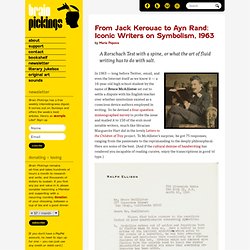

View from the Hill (Why Sunsets Matter) A Booklover's Map of Literary Geography circa 1933. By Maria Popova On the Bostoncentricity of literature, or what “our first man of letters” has to do with Poe.

Two of my great loves — maps and books — converged on my friend Wendy‘s wall, where I spotted this stunning vintage map of “literary geography.” Titled The Booklovers Map of America Showing Certain Landmarks of Literary Geography and created by pictorial cartographer Paul M. Paine in 1933, the map zooms in on the biggest literary cities and places “The Birthplace of American Literature” squarely in the Boston/Cambridge area. A few closeups: With its charmingly unpunctuated, almost stream-of-literary-consciousness text, the map is as much a cartographic treasure as it is an almanac of early twentieth century literary celebrity. For more unusual, creative, culturally sensitive maps, see these 7 fantastic books of and about maps. Donating = Loving Bringing you (ad-free) Brain Pickings takes hundreds of hours each month. Brain Pickings has a free weekly newsletter.
Share on Tumblr. From Jack Kerouac to Ayn Rand: Famous Writers on Symbolism, 1963. By Maria Popova A Rorschach Test with a spine, or what the art of fluid writing has to do with salt.

In 1963 — long before Twitter, email, and even the Internet itself as we know it — a 16-year-old high school student by the name of Bruce McAllister set out to settle a dispute with his English teacher over whether symbolism existed as a conscious device authors employed in writing. So he devised a four-question mimeographed survey to probe the issue and mailed it to 150 of the era’s most notable writers, much like librarian Marguerite Hart did in the lovely Letters to the Children of Troy project.
To McAllister’s surprise, he got 75 responses, ranging from the passionate to the reprimanding to the deeply philosophical. Here are some of the best. Symbolism arises out of action and functions best in fiction when it does so. I never consciously place symbolism in my writing. After all, each story is a Rorschach Test, isn’t it? Via The Paris Review Donating = Loving Share on Tumblr. Transmedia Storytelling & New Media Literacies.
Rhetorical Tropes. Daniel Chandler Rhetorical Tropes Most contemporary semioticians regard rhetoric (or at least aspects of it) as falling within the domain of semiotics (Nöth 1990, 338) . The study of what Saussure called 'the role of signs as part of social life' could not exclude the ancient art of persuasion. Whilst a general overview of rhetoric is beyond the scope of this text, a concern with certain key tropes (or figures of speech) is so prominent in semiotic theory that one cannot embark on an exploration of semiotics without some understanding of this topic. Academic interest in rhetoric, or at least in the epistemological implications of certain tropes, was revived in the second half of the twentieth century by structuralists such as Claude Lévi-Strauss and Roman Jakobson, the self-styled formalist Hayden White, poststructuralists such as Jacques Derrida and Jacques Lacan, and cognitive semanticists such as George Lakoff and Mark Johnson.
Metaphors need not be verbal. For ('She owns a '); References. The Valve - A Literary Organ.